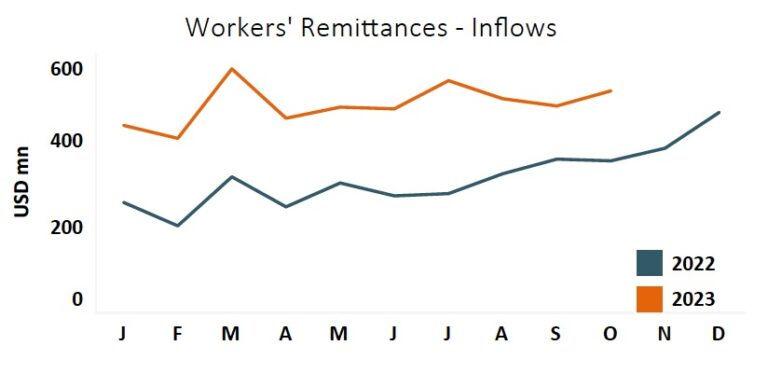ECONOMYNEXT – Sri Lanka’s gross overseas reserves grew marginally from $3,540 million in September to $3,562 million in October, after a decline within the earlier three months, following a discount in reserve quotas.
Sri Lanka minimize the statutory reserve ratio in August and dumped giant quantities of liquidity on the interbank market, though the central financial institution offered among the banknotes it had purchased over the previous two years to focus on potential manufacturing and set off a foreign money disaster and a few to scrub it up.
The central financial institution’s reserve collections slowed or declined, particularly after June, as preliminary confidence within the foreign money weakened because the company moved to the confidence-inspiring “versatile trade charge” present in most defaulting international locations in Africa and Latin America that go to the IMF.
The central financial institution’s internet overseas property additionally fell in September, pointing to an increase in loans.
There have been a number of one-off occasions within the interval associated to the debt restructuring, within the interval by which price reserves had been in place.
Nonetheless, personal lending is predicted to select up within the coming months, leaving much less room for unhealthy rates of interest.
Analysts have known as for a ban on the central financial institution’s powers to borrow by means of swaps, as a part of measures to stop a second sovereign default, stem social unrest and excessive nominal rates of interest regardless of financial instability.
Beneath a brand new financial legislation backed by the IMF, the central financial institution can proceed to lend by means of swaps and ‘print’ cash. Additionally, the central financial institution can print cash to sterilize outflows and mistarget rates of interest.
In the meantime, printing cash to focus on potential manufacturing (a so-called John Regulation clause/IS-LM), which was not allowed beneath the earlier legislation however was utilized within the run-up to the state’s chapter, has been legalized, making there may be extra room to proceed critics say they deny financial stability to financial actors or elected governments.
READ MORE: Sri Lanka’s new central banking legislation with John Regulation clause returns to classical mercantilism
Sri Lanka’s reserve-harvesting central financial institution tends to chop rates of interest, print cash by means of open market operations to drive the speed minimize, and miss reserve targets within the second 12 months of an IMF program as lending slows is growing, analysts warn.
Rates of interest can’t be stored low with open market operations, however solely by sustaining steady trade charges (and ensuing low inflation) for a couple of years and preserving the foreign money steady within the subsequent Fed cycle by means of well timed charge hikes.
Along with printing cash for development, the central financial institution additionally has authorized powers to print cash to spice up inflation to five p.c, which is greater than twice the extent of central banks that present financial stability to financial actors, beneath the brand new IMF-backed legislation.
Central banks delicate to the IMF are inclined to revert to the company, a phenomenon generally known as relapse (or Many Completely happy Returns), attributable to working frameworks that try and defy the legal guidelines of nature, generally generally known as the Unimaginable Trinity of financial coverage targets or IS /LM-BOP, involved with concentrating on potential output or decreasing rates of interest with inflationary open market operations, claiming that inflation is under goal. (Colombo/November 11, 2023)
learn extra

